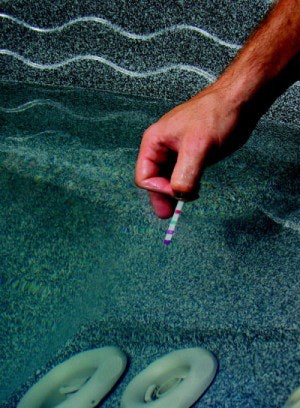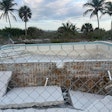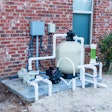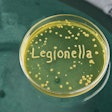
Water is water — two small atoms of hydrogen clinging to a single large oxygen atom. The formula is the same for both pool water and spa water. But when it comes to the chemistry and care of pool and spa water, you might as well be comparing apples and . . . pears.
The two are related, of course. Both become contaminated during normal use. Both typically use halogen sanitizers and filtration as the backbone of a routine maintenance program. But the differences give us more useful information about actually keeping them clean.
The main distinction to keep in mind when considering spa care versus pool care is that bather waste concentration in a spa is much higher than a pool.
Simple math demonstrates that just two people in a 400gallon spa is equivalent to 75 people in a 15,000-gallon swimming pool. After a party of that size, a pool owner would expect to do some cleaning. Spa owners should expect the same.
Exacerbating this difference is the fact that people in spas produce more waste than people in pools. The warm water causes their pores to open, and increases the rate of body fluid excretion — a fact some find distasteful, but which is nonetheless unavoidable.
"If you're in a 100 degree spa, you will definitely be sweating. And the chemical components of sweat," notes Meyer, just telling it like it is, "are basically the same as pee."
At the same time, spa jets scour the skin, exfoliating dead skin cells, dislodging oils and whatever else might be clinging thereon.
And, because the water is hot and churning, it evaporates much more quickly than pool water, leaving wastes behind in a more concentrated state.
Getting Physical
The implications of these differences are manifold. Let's start with filtration, the backbone of the spa's water-cleaning system. The filter, of course, physically removes waste and debris that not only make water cloudy but impede sanitizer performance.
Cartridge filters are common on spas because they're easy to remove, clean and replace. And a cartridge filter's pleated polyester is particularly good at removing oily contaminants, which will certainly be present in a regularly used spa.
In order to keep a cartridge filter in good working order — essential for good spa maintenance — the filter must be diligently cleaned. This is standard advice and simple common sense, but it bears constant reminding because of its significance.
A good rinsing on a weekly basis will get rid of large particles, but a deep cleaning every month or two with a commercial cleaning product designed for that purpose can make a big difference in water clarity and filter life.
Make sure the cleaner can break down and remove oily, greasy substances. If these are allowed to build up on the surface of the filter media, it cannot do its job, and that's trouble for the spa.
It's also problematic if a spa does not turn over often enough. "We need to get the water in the tub to the filter as often as possible to remove the solids being contributed by the bather," says Puetz.
So while a pool may turn over once every eight hours, the goal for a spa is once every 30 minutes.
With a cleanup job this daunting, a spa may need some specialized help with smaller particles and oily waste. A well-cared-for filter will get the large particles, but tiny microparticles can easily pass through a spa filter and remain suspended in the water, causing an unappealing haze.
"Worse," says Puetz, "these particles develop a negative electrical charge and since the charges are all alike, they repel one another and do not clump together, which would otherwise make them easier to filter out."
That's entirely too much negativity for a healthy spa. Puetz recommends a clarifier, which contains positive ions that seek out these negative particles and neutralize their charge.
They then coalesce into particles large enough to be caught by the filter.
Oily bather waste is another problem that can overwhelm the filtration system. This type of waste does not mix well with water, so water-soluble chlorine and bromine shock treatments alone may be ineffective.
Enzymes are sometimes necessary to keep this oily scum from building up along the water line and in pipes and the filter. Enzymes will break down oily waste so that it can be attacked and destroyed by a shock treatment.
But make sure you use enzymes that will attack the type of oils you are facing, and that are well suited for spa use, Puetz cautions. "It is important to select enzymes that can tolerate the typical sanitizer levels commonly found in spas."
Calcium And pH
When it comes to managing chemical factors of spa water, as opposed to the physical removal of waste by the filter, the discussion moves to topics such as water balance and total dissolved solids.
First among these is pH, and the ideal range for this parameter is the same for both pools and spas (7.2 – 7.8). In a spa, however, pH will tend to drift higher, notes Meyer. This is due to aeration and higher water temperature, which causes CO2 to be released into the air, driving pH up.
A spa's hot, churning water makes control of this factor crucial, adds Puetz. "A pH even slightly outside the normal range will have a profound effect on water quality and the likelihood of scale formation or corrosion," he says.
If a hot tub has low pH, or corrosive water, then the tub's higher temperature and water velocity make it more destructive to the metallic components of heat exchangers and plumbing fixtures.
In this situation, chlorine levels are much harder to maintain because the sanitizer is much less stable at low pH. Large quantities will be consumed in these conditions; although, paradoxically, the chlorine that remains is much more effective in this acidic water.
At pH levels above 7.8, on the other hand, water has the tendency to form scale or become cloudy. This whitish substance that precipitates out of the water is mainly calcium, whose rather unusual solubility property has important implications for spas.
Most substances are more soluble at higher temperatures; many current spa professionals will remember middle school science experiments that demonstrated that more sugar or salt will dissolve in hot water than in cool water.
But calcium is different. As the temperature of the water goes up, less calcium dissolves. Or conversely, more calcium drops out of solution in the form of calcium scale or particulate suspension.
"That's why calcium hardness levels need to be lower in spas (between 150 and 250 ppm) than in pools," says Meyer. "And that's also why calcium usually precipitates out at the heater, because that's where it's hottest."
This is the secret behind the mysterious flakes which can sometimes be found at the bottom of electrically heated hot tubs. These are formed when the spa is not in use and the heater is turned down but still set above ambient temperature, and the pump is running slowly, maintaining circulation.
During this period some calcium can build up around the heat exchanger; when the spa is fired up for use and the flow velocity suddenly raised, the scale is stripped from the heating element in small fragments which eventually come to rest in the tub.
Appearances notwithstanding, this is not such a bad thing, Puetz notes. "You can explain to customers that this is better than having the scale build up and cause heater failure later on," he says.
Given the annoyance and damage caused by calcium in spa water, it's tempting to consider removing it with a conventional water softener.
Not a good idea, says Puetz. High levels of calcium hardness may cause cloudy water and scale, but water with low levels of calcium will actually attack metal fittings and heat exchangers resulting in damage to the fittings and pinhole leaks in the heater. When such corrosion occurs, it is also common for stains to appear on surfaces.
Stains And TDS
Fortunately, common spa surfaces are not as prone to staining as many pool surfaces. But stains and colored water remain issues in spas just as they are for pools.
Iron and copper are the usual culprits, sneaking into the vessel during the initial fill. And that's why a dose of sequestering agent is a good idea at this time. Iron in fill water is colorless but if present in sufficient concentration will react instantly with chlorine to produce that familiar rusty red precipitate, either in the water or on the walls.
As mentioned above, if pH or calcium levels are low, spa water will aggressively attack metal in the system, making it a second source of iron or copper in spa water. As the corrosive water eats into copper or iron components in the plumbing, ions are released into the spa causing discoloration and staining.
In the absence of continuous good water balance, as insurance, regular use of a sequestering agent provides a good defense against this possibility.
Appropriately, TDS is a final consideration in contrasting pool and spa chemistry. It is the sum of everything that's dissolved in the water, from calcium to metals to bather waste.
TDS builds over time in any vessel of water, but it builds a lot faster in spas due to their concentrated bather loads, treatment products and rapid evaporation.
As one would expect, lots of dissolved solids will make the water cloudy and get in the way of sanitizer performance. Draining is the only answer. Every three to four months is recommended, or when TDS climbs to 1,500 ppm over startup level.
Bacteria In Paradise
The final factor of the water chemistry triad is sanitization. When humans enter the spa, they bring not only the bodily wastes previously discussed, but also tiny living things that can make you sick.
These organisms like warm water as much as anyone, and they eat bather waste, so for them a poorly sanitized spa is a very inviting prospect indeed! It's even better than a poorly sanitized swimming pool, where the water is cold and bather waste is less abundant.
Given such an appealing environment, they will immediately go about the business of reproduction — the details of which need not concern us here. The point is to get rid of both waste and bacteria, and do it very quickly and consistently.
The advent of ozone injection systems in spas has helped in this process, as ozone kills and oxidizes swiftly, but ozone by itself is not enough to sanitize a spa.
Ozone is injected and quickly neutralized within the plumbing of the spa, notes Meyer, "so you can have that pipe beautifully sanitized, but once you get out to where the people are, you've got to make sure that the bacteria coming off one body doesn't infect another."
You need something lingering in the water between the bodies that will kill bacteria — what professionals call a residual sanitizer, such as chlorine, bromine or biguanide, which stays active over time.
"Even spa water that is clean begins to degrade the moment a bather steps into it," says Meyer. "There's bacteria coming off the body, entering the water, and if you don't have a residual of PHMB, chlorine or bromine, you run the risk of infection."
Pseudomonas and Legionella are two types of bacteria that favor spas over swimming pools. Pseudomonas is a common organism, that if left unkilled in a spa can be jet-driven deep into the dilated pores of a spa bather, where it causes a rash.
It's not life threatening, but it's not pleasant either, causing red, irritated skin and blisters.
Legionella, the source of Legionnaires' disease, is the other major threat. Less common than Pseudomonas, Legionella is more dangerous. Borne on tiny droplets of untreated, turbulent spa water, this bacteria can be inhaled and infect the lungs of a bather causing severe respiratory problems.
Fortunately these bacteria fall easy prey to any good disinfectant, at which point they join the mass of waste that must be removed from the spa.
Different types of waste are removed in different ways. Ammonia, for instance, a common body waste, will react with free chlorine in the water to produce chloramines, a smelly and only marginally effective sanitizer.
But when the spa is effectively shocked, says Meyer, the ammonia reacts to form nitrogen gas, which literally floats off into the atmosphere. Other molecules may end up as CO2 gas and depart the spa as well.
Dead bacteria bodies, she adds, may be filtered or, if given enough time, the sanitizer can penetrate the cell wall and dismantle its components.
Common Language
On the whole, many of these notes on care and sanitization bear close resemblance to pool maintenance. And indeed, the two vessels speak the same language and have precisely the same end in mind: crystal clean water.
The main differences to bear in mind when mentally switching from cold to hot water care are temperature and concentrated bather load. Most of the important distinctions in biological, physical and chemical water treatment of spas follow from these two disparities.












































